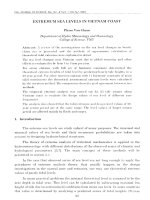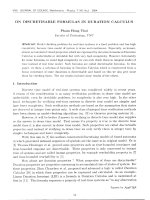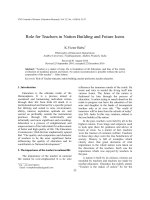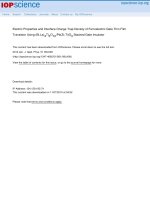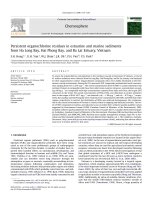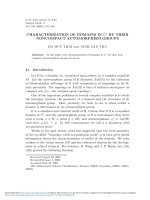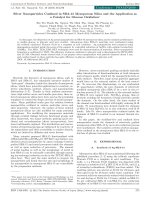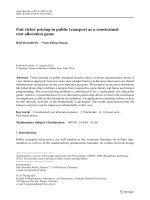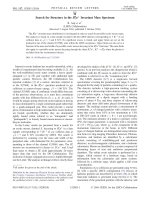DSpace at VNU: Electric field-controlled magnetization in exchange biased IrMn Co PZT multilayers
Bạn đang xem bản rút gọn của tài liệu. Xem và tải ngay bản đầy đủ của tài liệu tại đây (1.3 MB, 6 trang )
Home
Search
Collections
Journals
About
Contact us
My IOPscience
Electric field-controlled magnetization in exchange biased IrMn/Co/PZT multilayers
This content has been downloaded from IOPscience. Please scroll down to see the full text.
2013 Adv. Nat. Sci: Nanosci. Nanotechnol. 4 025017
( />View the table of contents for this issue, or go to the journal homepage for more
Download details:
IP Address: 132.174.255.116
This content was downloaded on 22/06/2014 at 14:50
Please note that terms and conditions apply.
IOP PUBLISHING
ADVANCES IN NATURAL SCIENCES: NANOSCIENCE AND NANOTECHNOLOGY
Adv. Nat. Sci.: Nanosci. Nanotechnol. 4 (2013) 025017 (5pp)
doi:10.1088/2043-6262/4/2/025017
Electric field-controlled magnetization in
exchange biased IrMn/Co/PZT
multilayers
D T Huong Giang1,2 , N H Duc1 , G Agnus2 , T Maroutian2 and P Lecoeur2
1
Nano Magnetic Materials and Devices Department, Faculty of Engineering Physics and
Nanotechnology, VNU University of Engineering and Technology, Vietnam National University, Hanoi,
E3 Building, 144 Xuan Thuy Road, Cau Giay, Hanoi, Vietnam
2
Institut d’Electronique Fondamentale, UMR CNRS and Universit´e Paris-Sud, F-91405 Orsay, France
E-mail:
Received 28 February 2013
Accepted for publication 3 April 2013
Published 8 May 2013
Online at stacks.iop.org/ANSN/4/025017
Abstract
Electric-field modulating exchange bias and near 180◦ deterministic magnetization switching
at room temperature are demonstrated in simple antiferromagnetic/ferromagnetic/ferroelectric
(AFM/FM/FE) exchange-coupled multiferroic multilayers of IrMn/Co/PZT. A rather large
exchange bias field shift up to Hex /Hex = 500% was obtained. This change governs mainly
the electric-field strength rather than the applied current. It is explained as being realized
through the competition between the electric-field induced uniaxial and unidirectional
anisotropies. These results show good prospects for low-power spintronic devices.
Keywords: magnetoelectric coupling, exchange bias field, magnetization switching,
piezoelectric, electric-field induced magnetization
Classification numbers: 4.11, 5.00
remain challenging for applications in information storage
technologies. Firstly, all metal spintronic devices have low
resistances; secondly, the critical current density to move
domain walls is still too high for the economization of the
power consumption [2]. In order to tackle these difficulties,
electric (E) field-induced magnetization switching is a
prospective solution [1, 3–6]. That approach includes E-field
induction of carrier density in semiconductor systems [7],
high k electrolyte and insulator to change interfacial electronic
states [8] and magnetoelectric effect, which occurs in
multiferroic-type materials consisting of both ferromagnetic
and ferroelectric orders [9–11].
For magnetoelectric coupling systems, the main principle
of E-field controlled magnetization manipulation is that
ferroelectric phases are used to generate strain that is
transferred to the magnetic phase and the magnetization
orientation can be influenced, thanks to the inverse
magnetostriction (Villary effect) [12]. In this case, the stress
sensing phase is preferred with a highly magnetostrictive
material where the maximal change in the magnetization
1. Introduction
Modern spintronics has become increasingly important
because of its potential impact on memory technologies
and magnetic sensors (see [1–5] and references therein).
Traditionally, the function of these devices is based on
the magnetic-field induced magnetization switching. In
nanostructures, however, this physical mechanism is not
efficient enough to control the magnetic bits due to the large
current. In particular, when approaching the downscaling
limits (e.g. in densely packed arrays) the unavoidable
distribution of writing parameters coupled to the large stray
fields will lead to spreading program errors and may cause
influence on neighborhood architectures. In this context, the
current-induced (or spin-transfer driven) switching mode is
considered to be more efficient; however, two main facts still
Content from this work may be used under the terms of
the Creative Commons Attribution 3.0 licence. Any further
distribution of this work must maintain attribution to the author(s) and the
title of the work, journal citation and DOI.
2043-6262/13/025017+05$33.00
1
© 2013 Vietnam Academy of Science & Technology
Adv. Nat. Sci.: Nanosci. Nanotechnol. 4 (2013) 025017
H G D Thi et al
laser deposition (PLD). The 220 nm-thick PZT films were
then epitaxially grown at 600 ◦ C on the LSMO/STO substrate.
In this case, a KrF excimer laser of 248 nm wavelength
was used with 2 Hz repetition and about 2.2 mJ cm−2 energy
density in an O2 gas pressure of 120 mTorr for LSMO
deposition and in a N2 O ambient of 260 mTorr for PZT
deposition, followed by a cooling-down procedure under
300 Torr of pure oxygen atmosphere. The exchange coupled
to the strong AFM/FM IrMn/Co magnetic bilayer system
is realized in the structure of Ta/Co/IrMn/Ta by magnetron
sputtering with low Ar pressure of 5.8 × 10−4 mTorr at room
temperature on top of the PZT layer. During the deposition,
an external magnetic field of 1000 Oe was applied along [001]
direction of single crystal PZT to induce an in-plane magnetic
easy axis and exchange coupling. The patterned films are
fabricated using micro-patterning techniques processes as
illustrated in figure 1. In this configuration, Ta/Co/IrMn/Ta
structures act as a cap as well as electrode layers.
The x-ray diffraction (XRD) system (Rigaku 3272) with
Cu-Kα radiation was used to examine the crystal orientation
of the PZT films. The surface morphology of the PZT
films was characterized by atomic force microscopy (AFM)
measurements. A ferroelectric test system (Precision LC
Radiant Technology) was used to measure their electrical
properties. Two types of measurements were applied in this
work: firstly, the bottom electrode Ta/Co/IrMn/Ta/LSMO
is connected to the drive of the precision LC (denoted
as the positive branch), and secondly, the Ta/Co/IrMn/Ta
top electrode is connected to the drive (i.e. negative
branch). Magnetic properties are investigated by means of
the magneto-optical Kerr effect (MOKE). All experimental
measurements are performed at room temperature.
Figure 1. Schematic of microfabrication process for patterned
Ta/IrMn/Co/Ta/PZT/LSMO/STO structures. (a) Bottom electrode
LSMO layer grown on the STO(001) substrate; (b) the
heterostructure of PZT layer was epitaxially deposited on a part of
the top of LSMO layer using a mark to shield; (c) the magnetic
structures Ta/Co/IrMn/Ta, which act as caps as well as electrode
layers was deposited by sputtering technique via circular holes
fabricated using UV lithography and liftoff; and (d) finally,
mounting chip on a plastic printed board, electrically bottom and
top contacted using wire bonding.
direction can reach up to 90 ◦ . This concept of the
strain-driven magnetization rotation has been demonstrated
in several spin-valve based multiferroic heterostructures,
in which both the E-field induced magnetization and
magnetoresistance were reported [13–16]. On the other
hand, E-field control of exchange bias in antiferromagnetic/
ferromagnetic/ferroelectric (AFM/ FM/FE) heterostructures
could lead to deterministic 180 ◦ magnetization switching.
This is of great significance for information storage such as
magnetoelectric random access memories (MERAM), but has
still been difficult to realize [3, 17–19].
In this work we report an alternative approach in
achieving power-efficient E-field control of exchange bias
in high-quality AFM/FM/FE IrMn/Co/PZT multiferroic
multilayers, where the near 180 ◦ deterministic-type
magnetization switching is investigated using the inverse
piezoelectric effect.
3. Experimental results and discussion
A typical θ–2θ XRD patterns spectrum of a 220 nm-thick
PZT film grown on LSMO/STO/Si(001) is shown in
figure 2(a), indicating a purely (00l) orientated perovskite
structure. It indicates that the LSMO and PZT layers are
preferentially oriented along the c-axis perpendicular to the
surface of STO substrate. The AFM images with scanning
1 × 1 µm2 area are shown in figure 2(b). The two-dimensional
AFM picture manifests that most of the PZT grains are
2. Experimental
Before fabricating Pb(Zr, Ti)O3 (PZT) films, a 40 nm-thick
La0 .67 Sr033 MnO3 (LSMO) layer was firstly epitaxially grown
on 500 µm-thick SrTiO3 (STO)/Si(001) substrate by pulsed
Figure 2. θ –2θ XRD patterns of the as-deposited PZT/LSMO/STO thin film plotted in logarithmic scale. (a) 2D- and 3D-AFM image
recorded over the scan area 1 × 1 µm2 (b) of the PZT thin films deposited on 40 nm-thick LSMO bottom electrode layer before micro
fabricating.
2
Adv. Nat. Sci.: Nanosci. Nanotechnol. 4 (2013) 025017
H G D Thi et al
Figure 3. C–V (a) and J–V (b) characteristisc of {Ta/IrMn/Co/Ta}/PZT/LSMO/STO film.
Figure 4. Magnetization loops measured under bias voltages V 25 V (a), magnetic coercivities and exchange bias fields (b) and
magnetization change under applied voltage at the fixed magnetic field of −132 Oe (c). The bias voltages are connected to the bottom
electrode (positive branch).
equiaxed. The three-dimensional photograph, however, shows
conical-shaped grains with a root-mean-square roughness of
about 3 nm, which promotes a sufficiently flat surface for the
subsequent growth of the magnetic layers (figure 2(c)).
Shown in figure 3(a) is the C–V (and the corresponding
conversional C–E) characteristics performed at 10 kHz for the
investigated PZT films. The drive is connected to the bottom
electrode (i.e. in the positive branch) and the dc voltage was
swept from 7 to −7 V and then reversely swept again. In
this case, the C–V characteristic exhibits the typical butterfly
shape with asymmetry. The coercivity is shifted to the positive
applied voltage and an enhancement of the capacitance is
accompanied. Indeed, the coercive fields of the film are of
+63.6 and −4.5 kV cm−1 , which yield an absolute coercive
field of 34.05 kV cm−1 . This asymmetry can be related to
the dissimilar electrodes with different mobile and interface
charge traps [20] and different work function [21].
Presented in figure 3(b) is the leakage current density
data, indicating a more pronounced asymmetry. For the
negative branch, the leakage current strongly increases at the
low applied voltages (between 1.0 and 1.5 V), and reaches
a value as large as 10−1 A cm−2 at E = 60 kV cm−1 . This
large current density increases with increasing voltage and
finally almost saturates with a value of 10 A cm−2 at E >
875 kV cm−1 . For the positive branch, leakage currents as
low as 10−3 A cm−2 remain in the electrical fields up to
–800 kV cm−1 , indicating a high structural quality of the
Figure 5. Magnetization loops measured under applied voltage for
the positive (15 V) and negative (−15 V).
ferroelectric layer. The leakage current jumps up at E =
−810 kV cm−1 and the saturation follows after. Note that
between +17 and –17 V applied voltage, the corresponding
leakage current is always much higher for the negative
branch than for the positive one, e.g. – 5 V;10−1 A cm−2 and
5 V;10−5 A cm−2 . This may relate to the fact that the Schottky
barrier between magnetic and PZT layers induced a diode
behavior [6, 22].
Large electrical currents flowing into the structure under
electric field may give a certain contribution of the Joule effect
and may affect the magnetic properties of the magnetic layers.
3
Adv. Nat. Sci.: Nanosci. Nanotechnol. 4 (2013) 025017
H G D Thi et al
Figure 6. Normalized magnetization loops measured under bias voltages up to 40 V (a), magnetic coercivities and exchange bias fields (b)
and magnetization change under applied voltage at the fixed magnetic field of –132 Oe. The bias voltages are connected to the top electrode
(negative branch).
In order to avoid this factor, the positive branch configuration
was firstly considered, where the low leakage current almost
exists in the whole applied voltage range. The normalized
magnetization loops measured under various bias voltages
(V) are illustrated in figure 4(a). It is clearly seen that, for
the unbiased sample (V = 0), the existence of a clear shift
of the loop reflects the existence of an exchange bias field
Hex (≈79.5 Oe). When applying a bias-voltage across the PZT
layer, the negative magnetic coercivity decreases, while the
positive field increases, indicating the suppression of Hex
(figure 4(b)). Inspection of the magnetic loops in figure 4(a)
suggests that it should be possible to reverse the magnetization
of the magnetic layer upon suitable electric and magnetic field
biasing. A modification of the magnetization can be indeed
processed in fixing a external magnetic field of Ha = −132 Oe
as shown by the arrow in figure 4(a). At this bias magnetic
field, the normalized magnetization M/Ms already lowers to
the value of 0.32 at V = 0. When increasing applied voltage
V, the magnetization continues to lower, switches its sign at
V ≈ 20 V and reaches the value of –0.32 at about V ≈ 25 V.
This electric-field bias dependence of the magnetization is
described in figure 4(c). Electric-field tuning of exchange
bias and deterministic magnetization reversal observed in
AFM/FM/FE multilayers can be understood as an intrinsic
magnetization phenomenon resulting from the competition
between the effective uniaxial anisotropy K eff (consists of the
uniaxial anisotropy constant K u and the E-field induced elastic
anisotropy term of (3/2)λσ ) and the anisotropy energy K ex
associated with the unidirectional exchange coupling [23, 24].
Although the leakage current exhibits the abrupt change
between the applied voltage of 15 and 20 V, the variation
of the magnetic coercivity and exchange bias field reflects
almost a unique tendency for the whole applied voltage
range (see figure 4(b)). This may imply that the magnetic
change depends mainly on the amplitude of the electric field
rather than the applied current. To tackle this point, the
magnetic loops measured under the bias voltages of 15 V
(with the current of 0.052 mA) and of −15 V (with the
current of 2.2 mA) are illustrated in figure 5. Surprisingly,
although the current is 40 times larger for the latter case, the
difference in coercivity field is a few per cent only. Thus,
this encourages measurement of the magnetic loops under
the bias voltage up to −40 V to study the piezoelectric effect
on the magnetization switching. The results are presented
in figure 6(a). It can be seen from this figure that when a
voltage of 40 V is applied, Hex significantly decreases from
60 to 10 Oe with Hex /Hex (40 V) = 500%. As shown by
the arrow in this figure, at the external bias magnetic field
of –100 Oe, the normalized magnetization M/Ms already
lowers down to the value of 0.65. When increasing applied
voltage V, the magnetization continues to lower, switches its
sign between −25 and –30 V and finally reaches the value of
–0.8 at about V = −40 V. The observed electric-field bias
dependence of the magnetization is described in figure 6(b).
Clearly, the near 180 ◦ deterministic magnetization switching
can be electrically realized in the investigated AFM/FM/FE
multiferroic multilayers.
4. Conclusion
To summarize, high-quality piezoelectric films have been
fabicated and used for electrically controlling the exchange
bias in AFM/FM/FE IrMn/Co/PZT multiferroic multilayers.
A rather large exchange bias field shift up to Hex /Hex =
500% was obtained. The asymmetry is observed in both
C–V and J–V characteristics, however, the exchange bias
field change depends mainly on the electric-field strength
rather than the applied current. The observed deterministic
magnetization switching near 180 ◦ shows great potential in
E-field writing of novel spintronics and memory devices.
Acknowledgment
This work was partly supported by the NAFOSTED of
Vietnam under the project number 103.02.86.09.
References
[1] Eerenstein W, Mathur N D and Scott J F 2006 Nature 442 759
[2] Maekawa S 2006 Concepts in Spin Electronics (Oxford:
Oxford Science Publications)
[3] Liu M, Lou J, Li S and Su N X 2011 Adv. Funct. Mater.
21 2593
[4] Scott J F 2007 Nature Mater. 6 256
[5] Bibes M and Barthelemy A 2008 Nature Mater. 7 425
[6] Lei N, Park S, Lecoeur P, Ravelosona D, Chappert C,
Stelmakhovych O and Holy V 2011 Phys. Rev. B 84 012404
[7] Chiba D et al 2008 Nature 455 515
[8] Endo M et al 2010 Appl. Phys. Lett. 96 212503
[9] Hu J M and Nan C W 2009 Phys. Rev. B 80 224416
4
Adv. Nat. Sci.: Nanosci. Nanotechnol. 4 (2013) 025017
H G D Thi et al
[10] Allibe J et al 2010 Appl. Phys. Lett. 96 142509
[11] Lei N, Park S, Lecoeur P, Ravelosona D and Chappert C 2011
Phys. Rev. B 84 012404
[12] Mamin H J, Gurney B A, Wilhoit D R and Speriosu V S 1998
Appl. Phys. Lett. 72 3220
[13] Liu M et al 2009 Adv. Funct. Mater. 19 1826
[14] Lou J, Liu M, Reed D, Ren Y H and Sun N X 2009 Adv. Mater.
21 4711
[15] Chen Y, Fitchorov T, Vittoria C and Harris V G 2010 Appl.
Phys. Lett. 97 052502
[16] Huong Giang D T, Thuc V N and Duc N H 2012 J. Magn.
Magn. Mater. 324 2019
[17]
[18]
[19]
[20]
[21]
[22]
[23]
[24]
5
Kleemann W 2009 Physics 2 105
Catalan G and Scott J F 2009 Adv. Mater. 21 2463
He X et al 2010 Nature Mater. 9 579
Xiao B, Gu X, Izyumskaya N, Avrutin V, Xie J Q and Morkoc
H 2007 Appl. Phys. Lett. 91 182906
Masruroh and Toda M 2011 Int. J. Appl. Phys. Math. 1 144
Khan M A, Comyn T P and Bell A J 2008 Appl. Phys. Lett.
92 072908
Chung S H, Hoffmann A and Grimsditch M 2005 Phys. Rev. B
71 214430
Camarero J, Sort J, Hoffmann A, Garcia-Martin J M, Dieny B,
Miranda R and Nogues J 2005 Phys. Rev. Lett. 95 057204
